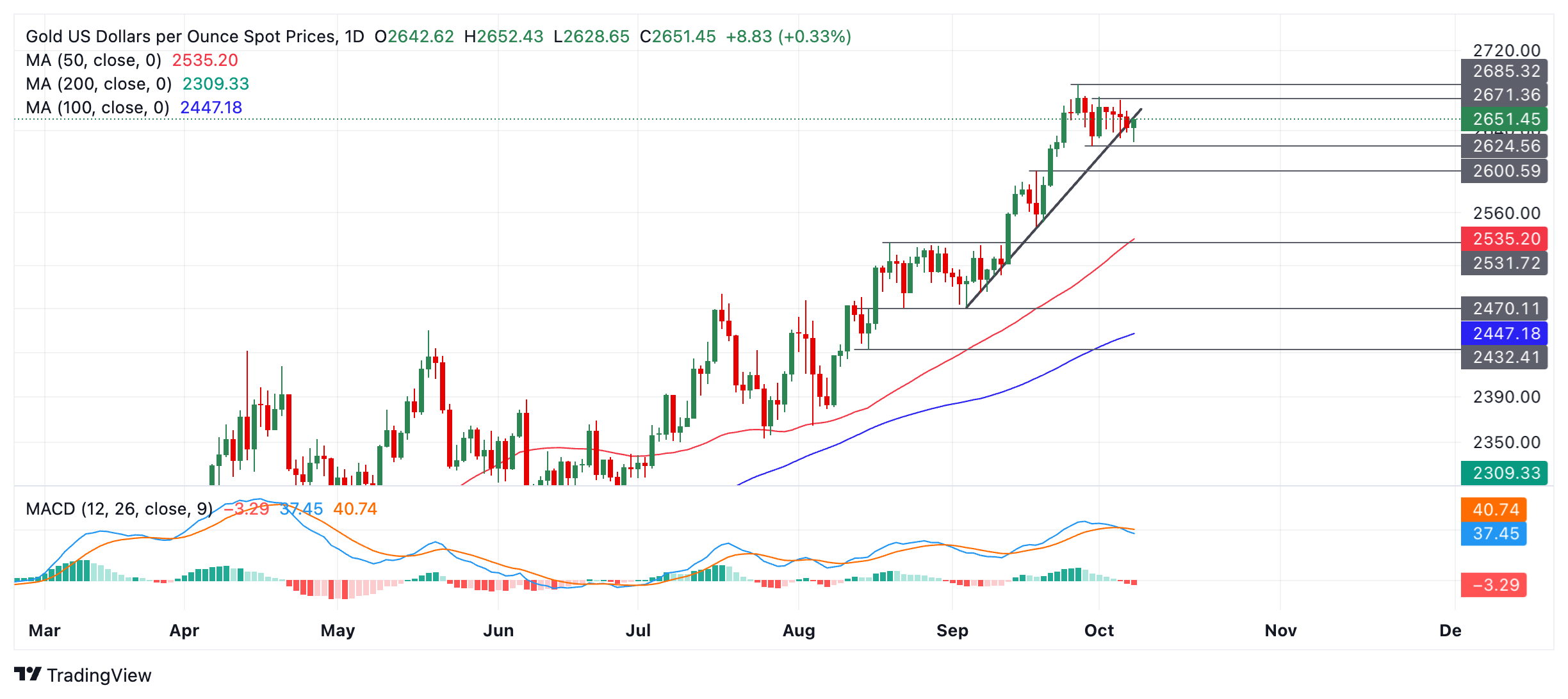- Gold is moving lower within its range as markets revise down their outlook for China, the world’s largest gold consumer.
- The precious metal is supported by ETF flows and safe haven demand amid rising geopolitical tensions.
- Technically, XAU/USD breaks a trend line while extending its market mode within a tight range.
Gold (XAU/USD) is trading at $2,630 on Tuesday as the yellow metal rises within the familiar $50 range of recent weeks.
Disappointment over the limited scope of the fiscal stimulus announced by China on Tuesday is a headwind for Gold, as China is the world’s largest consumer of the precious metal. The reduced chances that the Federal Reserve (Fed) will cut interest rates by another 50 basis points (bp) (0.50%) at its next meeting in November also weigh. The increasing probability that the Fed will only cut by 25 bps (0.25%), or even not cut at all, is a headwind for Gold because it suggests that the opportunity cost of holding the non-interest-paying asset will remain higher than previously expected.
Gold supported by ETF flows and safe haven demand
Gold rises, however, one of the factors supporting the yellow metal is the data that reveals a high demand for exchange-traded funds (ETFs) backed by Gold. These allow investors to buy shares in Gold instead of buying bullion . ETF net inflows have increased significantly over the summer, and this is often taken as a strong indicator of future demand trends.
In August, “physically backed gold ETFs globally added $2.1 billion,” the World Gold Council (WGC) said, extending its streak of inflows to four months.
This follows July, when Gold ETFs attracted $3.7 billion, the largest inflows since April 2022.
Gold also continues to provide an attractive safe haven amid rising geopolitical tensions. On Tuesday, Israel intensified its attacks on targets in Lebanon after a Hamas attack in southern Israel. Israeli forces also claimed to have killed a senior Hezbollah member in charge of budget and logistics.
In response to the relentless attack, which has claimed the lives of many of the group’s top leaders, the group’s deputy leader Naim Qassem said that the conflict between Hezbollah and Israel “was a war over who cries first, and that Hezbollah would not cry first, ” according to Reuters. He further added that Hezbollah’s capabilities remained intact.
Markets are also on edge anticipating a retaliatory attack by Israel against Iran for its ballistic rocket raid last week.
The general downward trend in global interest rates – despite the recalibration of their trajectory in the US – puts additional support on the price of Gold, as it increases its attractiveness as a portfolio asset.
Technical Analysis: Gold tests the trend line
Gold tests a major trend line as it continues to develop within a tight sideways range. The range has a top around $2,673 (Oct 1 high) and a bottom at $2,632 (Oct 4 low).
XAU/USD Daily Chart
The short-term trend is sideways, and given the technical analysis principle that “the trend is your friend,” it is more likely that it will not last with the price oscillating between the aforementioned poles.
A break above $2,673 would increase the odds of a resumption of the old uptrend, likely leading to a continuation to the round number target at $2,700.
A break below $2,632 would lead to a move lower at least to the low of $2,625 (September 30 low). A break below that level would likely see prices give way to support at $2,600 (Aug 18 high, round number).
On a medium and long-term basis, Gold remains in an uptrend, with the odds favoring an eventual resumption higher once the current period of consolidation has ended.
A breakout either above the top of the range or below the bottom would be required to confirm a new directional bias.
Interest rates FAQs
Financial institutions charge interest rates on loans from borrowers and pay them as interest to savers and depositors. They are influenced by basic interest rates, which are set by central banks based on the evolution of the economy. Typically, central banks are mandated to ensure price stability, which in most cases means targeting an underlying inflation rate of around 2%.
If inflation falls below the target, the central bank can cut base interest rates, in order to stimulate credit and boost the economy. If inflation rises substantially above 2%, the central bank typically raises core lending rates to try to reduce inflation.
In general, higher interest rates help strengthen a country’s currency by making it a more attractive place for global investors to park their money.
Higher interest rates influence the price of Gold because they increase the opportunity cost of holding Gold instead of investing in an interest-bearing asset or depositing cash in the bank.
If interest rates are high, the price of the US Dollar (USD) usually rises and, since Gold is priced in dollars, the price of Gold falls.
The federal funds rate is the overnight rate at which U.S. banks lend to each other. It is the official interest rate that the Federal Reserve usually sets at its FOMC meetings. It is set in a range, for example 4.75%-5.00%, although the upper limit (in this case 5.00%) is the figure quoted.
Market expectations about the Federal Reserve funds rate are tracked by the CME’s FedWatch tool, which determines the behavior of many financial markets in anticipation of future Federal Reserve monetary policy decisions.
Source: Fx Street
I am Joshua Winder, a senior-level journalist and editor at World Stock Market. I specialize in covering news related to the stock market and economic trends. With more than 8 years of experience in this field, I have become an expert in financial reporting.








